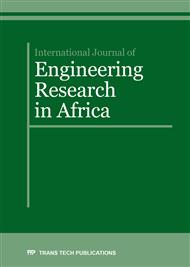p.1
p.8
p.21
p.32
p.45
p.53
p.73
p.90
p.102
Assessment of Gravel Properties Sourced within Oyo North Senatorial District: Case Study of Ogbomoso
Abstract:
The study evaluated the properties of gravel aggregate sourced within Oyo north senatorial district for concrete production in place of crushed granite crushed at exorbitant cost since characteristic properties show significant reflections on the qualities of gravel aggregate used and also play major role in determining the properties of hardened concrete.Samples of gravel from four commonly used borrow pits: Aroje, Bolanta, Sunsun and Olomi sites were obtained and tested for Aggregate Crushing Value (ACV), Aggregate Impact Value (AIV), Specific Gravity, Water absorption Capacity, Bulk Density, Moisture Content and Particle Size Distribution. On the average the results of the observation for the selected four locations were 22.56 g, 28.17 g, 33.37 g and 40.19 g for Aggregate Crushing Value (ACV), 2.44 g/ml, 2.53 g/ml, 2.57 g/ml and 2.62 g/ml for Bulk density, 0.17 %, 1.43 %, 2.42 %, and 2.48 % for moisture content, 2.02 %, 2.92 %, 2.00 % and 3.15 for water absorption, 2.52, 2.63, 2.60 and 2.55 for specific gravity, 41. 55 %, 45.25 %, 45.59 % and 47.08 % for aggregate Impact respectively.The study revealed that, gravel aggregates from Aroje has superior properties over those of Sunsun, Bolanta and Olomi as compared with coarse aggregate properties in BS 812: 1995 and BS 882: 1992. It is hereby recommended for coarse aggregate in concrete production.
Info:
Periodical:
Pages:
45-52
Citation:
Online since:
January 2017
Price:
Сopyright:
© 2017 Trans Tech Publications Ltd. All Rights Reserved
Share:
Citation:


